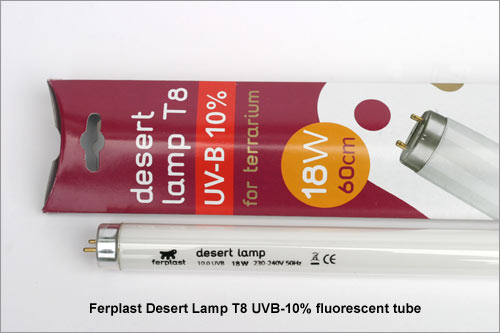|
29th
November 2007
A
set of lamps from a new range from Ferplast UK were donated
to me for testing, from ReptileZone, Bristol, two weeks
ago. Ferplast UK is the British distributor of pet-related
products from the Italian parent company, Ferplast S.p.A.
(www.ferplast.com)
The new product range includes three types of fluorescent
tube and matching compact lamp:
- daylight
lamp UV-B 2%
- tropical
lamp UV-B 5%
- desert
lamp UV-B 10%
 The
only lamp I have tested in any detail so far is one sample
of the Ferplast Desert Lamp T8 UV-B 10% tube (pictured,
right) The
only lamp I have tested in any detail so far is one sample
of the Ferplast Desert Lamp T8 UV-B 10% tube (pictured,
right)
Tests
are not complete, but my first sets of readings are a cause
for concern. This tube appears identical in its UV output
to the R-Zilla Desert 50 Series T8 tubes now withdrawn from
sale in the USA. (See the main
report)
It
has a virtually identical UV spectrum to these tubes, with
UVC and non-solar UVB, and high total UVB output. The only
difference seems to be in the phosphor used to produce the
visible light.
This
tube had an initial output of 148 µW/cm² total UVB, UV Index
21.3, at 6 inches distance, and 66µW/cm² total UVB, UV Index
9.4, at 12 inches distance (measured with Solarmeter 6.2
and 6.5 meters, respectively).
As
discussed in the main report, the UV Index (UVI) can be
used as an indicator of the "photobiological activity"
of a lamp compared to natural sunlight.
When
skies are clear, the UVI of direct, tropical sunlight rises
steadily from 0 at sunrise to levels of 10 to 14 or more,
but few animals are out and about under such strong light.
A small number of recordings taken in the field, alongside
basking lizards in the tropics - usually seen in early to
mid-morning or from mid-afternoon onwards - suggest that
reptiles which bask in full sun choose times of day when
UV levels are lower - the highest recorded UVI, for example,
being only 7.6 in a small study conducted by the author.
A
UVI of 9.4 is typical of full sun in late morning or early
afternoon in the tropics; this would appear to be too high
for even sun-loving species. A UVI above 16 -17 is not naturally
found in the most intense sunlight on the face of the earth;
UVI 21.3 would be positively dangerous if exposure was for
more than a few minutes.
I
have already notified Ferplast of my preliminary observations
and I will be testing this range of lamps fully in the coming
weeks and sending the full report to Ferplast. However,
if the one lamp I have tested is typical, I believe their
output to be hazardous and would advise caution with their
use.
In
normal circumstances I would not post this information on
this website before I have completed the tests on both of
the sample lamps, sent the report to the company and received
a response from them. However, yesterday I was told that
Reptile Zone have received reports of the deaths of several
hatchling bearded dragons, after the typical symptoms of
photo-kerato-conjunctivitis, following the use of new lamps
of this type in their vivaria.
These
reports have not yet been confirmed in writing, and it has
not been proven beyond reasonable doubt that excessive UV
was the cause of the problems. However these lamps do produce
non-solar UVB and high levels of low-wavelength solar UVB
which
would, in theory, cause just such problems at close range.
The
full report with more test results will be published here
as soon as possible.
If
you have purchased one of these lamps and are in any way
concerned about your reptile's health, please read the main
report and especially the section "Help!
I think my reptile has this problem..."
Frances
Baines
Return
to Index Page
|


















 The
only lamp I have tested in any detail so far is one sample
of the Ferplast Desert Lamp T8 UV-B 10% tube (pictured,
right)
The
only lamp I have tested in any detail so far is one sample
of the Ferplast Desert Lamp T8 UV-B 10% tube (pictured,
right)